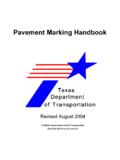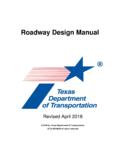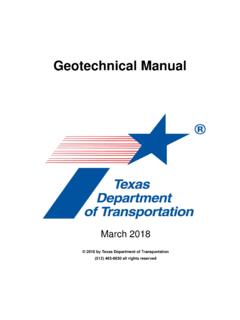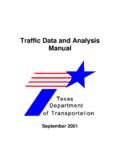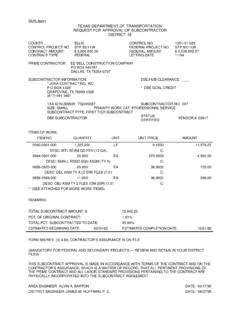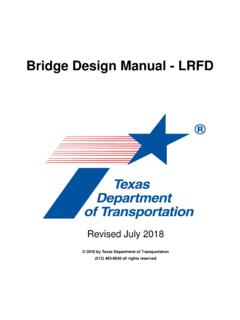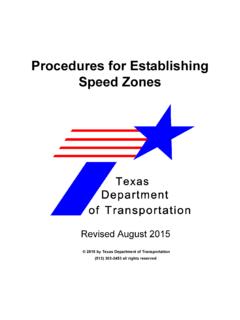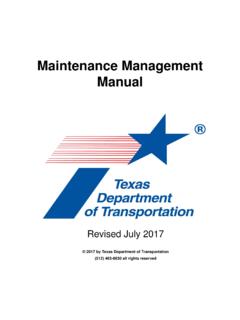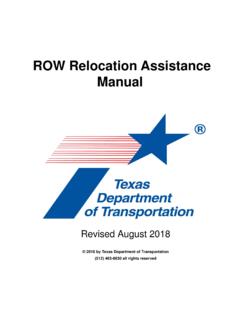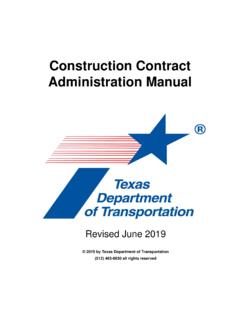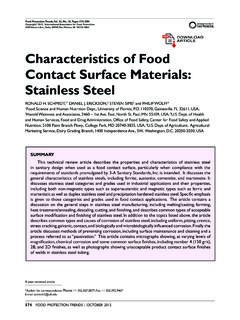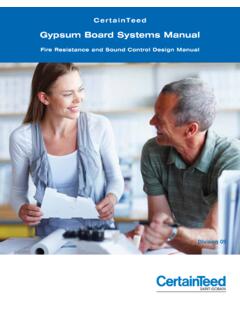Transcription of Concrete Repair Manual (CRM)
1 Concrete Repair ManualJanuary 2019 2018 by Texas Department of Transportation(512) 463-8630 all rights reservedManual Notice 2019-1 From:Graham A. Bettis, , Director, Bridge DivisionManual: Concrete Repair ManualEffective Date:January 25, 2019 PurposeThis Manual includes step-by-step Repair procedures for use on new and existing Concrete members cast for the Texas Department of Transportation ( txdot ).ChangesRevisions to this Manual include various editorial changes including reference to CST revised to MTD, reference to epoxy anchors revised to adhesive anchors, and patch revised to Repair ; revising Contractor s Responsibilities to include visual and non-destructive testing to ensure quality of repairs; incorporated procedure to address lifting strands on prestressed piling; added storage, temperature, humidity, and document controls to ensure material quality; added typical Repair detail and photos showing steps for intermediate spall repairs; revised Gravity-Fed Epoxy to Gravity-Fed Sealant to include other acceptable contact the Bridge Division with comments or Manual Notices are available in a PDF Repair Manuali txdot 11/2018 Table of ContentsChapter 1 IntroductionSection 1 Overview.
2 1-2 Section 2 Using the Concrete Repair Manual .. 1-4 Section 3 Standard Specification References to the Concrete Repair Manual .. 1-5 Section 4 Repairs and Repair Manual .. 1-6 Section 5 Repair Procedure Submission and Approval .. 1-7 Section 6 Quality Control/Quality Assurance.. 1-8 Section 7 Definitions and Abbreviations .. 1-11 Chapter 2 Damage Assessment and Repair TypesSection 1 Defining Concrete Spalls .. 2-2 Description.. 2-2 Notes .. 2-2 Spall Categories .. 2-2 Selecting an Appropriate Repair Procedure .. 2-3 Section 2 Voids Due to Honeycombing .. 2-5 Description.. 2-5 Investigating Honeycombed Regions .. 2-5 Repairing Honeycombed Regions .. 2-5 Section 3 Damage over Traffic .. 2-6 Description.. 2-6 Section 4 Prestressed Concrete Piling.. 2-7 Description.. 2-7 Reference .. 2-7 Notes .. 2-7 Damage Prior to Driving ( in the Fabrication Yard).
3 2-7 Damage During Driving .. 2-8 Lifting Strands.. 2-9 Section 5 Taking, Marking, and Patching Cores .. 2-10 Description.. 2-10 Selection Criteria .. 2-10 Taking Cores to Check Compressive Strength .. 2-10 Taking Cores to Investigate Potential Concrete Material Problems .. 2-10 Taking Cores to Investigate Specific Defects .. 2-11 Marking Cores .. 2-11 Patching Cores .. 2-11 Section 6 Trimming or Cutting Prestressed Concrete Girder Ends .. 2-12 Concrete Repair Manualii txdot 11/2018 Description.. 2-12 Provisions for Acceptance .. 2-12 Repair Procedure .. 2-13 Section 7 Recessing Prestressed Strands .. 2-14 Description.. 2-14 Repair Procedure .. 2-14 Section 8 Rail Damage Due to Vehicular Impact .. 2-15 Description.. 2-15 Assessment .. 2-15 Repair Procedure .. 2-15 Chapter 3 Repair Materials and ProceduresSection 1 Minor Spall Repair .. 3-2 Description.. 3-2 Material.
4 3-2 Repair Procedure .. 3-3 Commentary .. 3-5 Section 2 Intermediate Spall Repair .. 3-6 Description.. 3-6 Material .. 3-6 Repair Procedure .. 3-7 Commentary .. 3-16 Section 3 Major Spall Repair and Concrete Replacement .. 3-17 Description.. 3-17 Material .. 3-17 Repair Procedure .. 3-17 Commentary .. 3-21 Section 4 Bridge Deck Repair .. 3-22 Description.. 3-22 Selecting an Appropriate Repair Material .. 3-23 Repair Procedure .. 3-23 Commentary .. 3-26 Section 5 Crack Repair Pressure-Injected Epoxy .. 3-27 Description.. 3-27 Material .. 3-27 Repair Procedure .. 3-27 Commentary .. 3-29 Section 6 Crack Repair Gravity-Fed Sealant .. 3-30 Description.. 3-30 Concrete Repair Manualiii txdot 11/2018 Material .. 3-30 Repair Procedure .. 3-30 Commentary .. 3-31 Section 7 Crack Repair Surface Sealing .. 3-33 Description.. 3-33 Method 1: Rout-and-Seal Cracks.
5 3-33 Method 2: Surface Sealing.. 3-33 Concrete Repair Manual1-1 txdot 01/2019 Chapter 1 IntroductionContents:Section 1 OverviewSection 2 Using the Concrete Repair ManualSection 3 Standard Specification References to the Concrete Repair ManualSection 4 Repairs and Repair ManualSection 5 Repair Procedure Submission and ApprovalSection 6 Quality Control/Quality AssuranceSection 7 Definitions and AbbreviationsConcrete Repair Manual1-2 txdot 01/2019 Chapter 1 IntroductionSection 1 OverviewSection 1 OverviewThis Manual includes step-by-step Repair procedures for use on new and existing Concrete members cast for the Texas Department of Transportation ( txdot ). It includes a comprehensive list of com-mon Concrete distress and Repair methods. The methods adhere to industry standards and the provisions from applicable documents by the American Concrete Institute and American Society for Testing and Materials.
6 This Manual was developed in collaboration with various Repair material manufacturers to ensure that the procedures meet common proprietary requirements. In general, repairs to txdot Concrete structures should be implemented in accordance with the methods outlined in this Manual . However, unusual circumstances occasionally arise. Engineers may determine that methods differing from those outlined here are more appropriate in some to the Manual are summarized in the following 1-1: Manual Revision HistoryVersionPublication DateSummary of Changes2015-1 April 2015 New 2017 Revision adding Manual revision history to Chapter 1; revision breaking Chapter 1 into seven sections with no changes to content; revision adding Section 8, discussing rail damage due to vehicular impact, to Chapter 2; revisions for consistency with current DMS-4655; revised maximum application for neat product to 2"; various revisions to Chapter 3, Section 4, Bridge Deck Repair and Sec-tion 6, Crack Repair Gravity-Fed Epoxy for improved performance of repairs.
7 Minor formatting and editorial revisions in various Repair Manual1-3 txdot 01/2019 Chapter 1 IntroductionSection 1 Overview2019-1 January 2019 Various editorial revisions including: Reference to CST revised to MTD Reference to epoxy anchors revised to adhesive anchors. Various references to patch revised to 1, Section 6: Incorporated visual and non-destructive evaluation of Repair material as part of Contractor's Responsibilities (QC).Ch 2 Section 4: Added procedure to recess and coat lifting strands on pre-stressed piling after installation of 2, Section 8: Referenced Item 445, "Galvanizing" for Repair material to gal-vanized rail components. Added language that tests on new railing adhesive anchorage may be required by the 3, Section 1 Incorporated storage, temperature, humidity controls, and doc-ument controls to ensure material 3, Section 2: Incorporated typical Repair detail and photos showing steps for typical intermediate spall Repair .
8 Incorporated language for temperature controls for mixing and using chilled water. Added inspection prior to finishing Ch 3, Section 3: Added inspection prior to finishing Ch 3, Section 6: Gravity-Fed Epoxy revised to Gravity-Fed Sealant to include other acceptable sealants. Incorporated language to follow product specifications for maximum working 1-1: Manual Revision HistoryVersionPublication DateSummary of ChangesConcrete Repair Manual1-4 txdot 01/2019 Chapter 1 IntroductionSection 2 Using the Concrete Repair ManualSection 2 Using the Concrete Repair ManualWhen developing Repair or rehabilitation plans, the Engineer should specifically include which sec-tions of this Manual will be enforced. Chapter 2 includes information on assessing damage, distress limits, and common types of Concrete Repair . Chapter 3 includes information on various Repair materials and procedures for Concrete Repair work will include categorizing the type of distress as outlined in Chapter 2 and selecting a type of Repair material from Chapter 3.
9 In some cases, the material section includes enough information that choosing a corresponding type of Repair is not necessary. For instance, the sections on crack Repair do not require that corresponding Repair types be selectedEach section in this Manual is written as a stand-alone document, and individual sections contain all necessary information on material selection and application. It is not necessary to read the Manual from start to finish. Rather, the intention is that Inspectors and Contractors will need only to refer-ence the applicable section or sections. The sections are kept as concise as possible since they are intended for field Manual does not address post-tension strand, duct, or anchorage repairs. Repairs or defects associated with post-tension work should be addressed by the Bridge Division Construction & Maintenance Branch on a case-by-case Repair Manual1-5 txdot 01/2019 Chapter 1 IntroductionSection 3 Standard Specification References to the Concrete Repair ManualSection 3 Standard Specification References to the Concrete Repair ManualThe Concrete Repair Manual is referenced in several 2014 Standard Specification Items.
10 This sec-tion includes a list of each of those references, along with the corresponding Section to reference within this Specification ReferencesSpec ItemItem TitleSpec ReferenceRepair Manual Reference409 Prestressed Concrete (Defects and Breakage)Refer to Section for limits and Repair procedures when assessing damage to pre-stressed Concrete (Ordinary Surface Finish)Spalls are defined per Section , and repaired (based on severity) per Section , , or Most spalls in this category will be defined as minor and repaired per Section Concrete Struc-tural Members (Fabrication) (Workmanship)Recess prestressed strands per Section (Defects and Breakage)This item covers damage or surface defects that occur during fabrication, handling, storage, hauling, or erection of precast con-crete members. Any of the sections in this Manual could apply depending on the situation. 429 Concrete Structure Repair2 (Materials)3 (Construction Methods)Severity of the unsound, delaminated, or spalled Concrete is defined per Section After defining, select materials and imple-ment Repair per Section (Minor), (Intermediate), or (Major).
